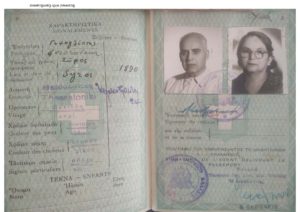Plasterers at the dawn of Thessaloniki’s great reconstruction
Full Description
The people depicted in the photographs are members of the Kapetanakis family at work. The Kapetanakis family initially moved from Syros to Athens and finally settled in Thessaloniki in 1923 to start a plaster workshop. Leonidas Kapetanakis was born in Syros around 1890 and moved to Athens at the beginning of the 20th century where he co-operatively ran a renowned plaster workshop. At the beginning of the 1920s, he left the co-operative and moved with his family to Thessaloniki where his plaster workshop would have no competition.
According to Dagkas, at that point in time, the exciting prospect of closer economic relations between Thessaloniki and ‘Old Greece’ was creating expectations for future business gains. Simultaneously, the mass arrival of refugees in Thessaloniki, as well as the resettlement of people from Constantinople and Smyrna who had managed to retain some of their financial assets, created a need for various types of housing and a demand for new workspaces, stores, and offices, establishing the conditions for a construction boom.
Leonidas Kapetanakis saw this as the family’s opportunity to innovate in a sector that had not yet taken hold in Thessaloniki and he was the first to bring marble dust processing to the city. He was also an excellent craftsman who used to say, ‘Wherever I throw plaster, a flower blooms’. Leonidas’ relatives report that his company ‘L. Kapetanakis and Sons’ was the only major decorative plaster company in Thessaloniki until 1950, with branches in Kavala and, for a short time, in Kastoria. His sons were Nikos Kapetanakis, the company foreman, and Christos Kapetanakis, who was responsible for the company’s financial operations. Their works include the plaster decorations of ‘Palataki’ (meaning ‘little palace’) and the plasterwork of the Bank of Greece building and Aristotelous Square.
By the end of the 1950s and the beginning of the ‘60s, the situation in the construction market had shifted. New plaster workshops were established in Thessaloniki offering their services at highly competitive prices, rendering the Kapetanakis company non viable. Gradually, the company dissolved and the Kapetanakis sons changed professions: Nikos Kapetanakis migrated to the US, where other members of the family had already resettled, while Christos Kapetanakis became a construction developer. This was the beginning of a new period of migration and reconstruction for Thessaloniki, the era of ‘antiparochi’ (the practice of land developers acquiring land by offering land owners apartments in the finished buildings) [see also EKT034].
To a degree, the family’s movements through space reflect the major shifts within Greek society during the first decades of the 20th century, after the integration of Thessaloniki and the New Lands into Old Greece, the Greco-Turkish war and the mass movement of populations across the Balkans and south-eastern Europe in general. At the same time, the family’s trajectory in business encapsulates the peaks and troughs of commercial and financial life in Thessaloniki and northern Greece, from the great demand for housing created between 1920 and 1924 to the post-war reconstruction of the city centre, while also exemplifying the migration flows from northern Greece to America and northern Europe over the 1960s and ‘70s.
Bibliography
Alexandros Dagkas, Contribution to the research into the economic and social evolution of Thessaloniki, Thessaloniki Commercial Chamber Studies No 2, Thessaloniki 1998.



